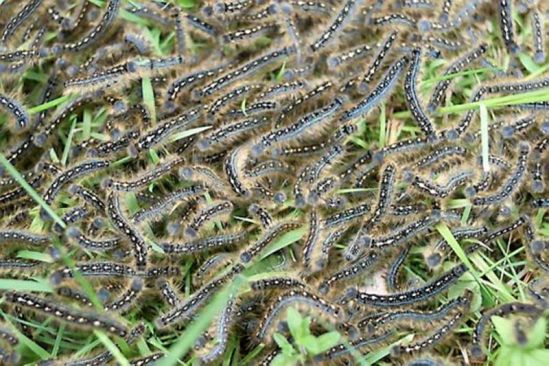Dale Odorizzi | May 30, 2018
As you walk around your yard and look at the beautiful buds on your apple and cherry trees, you notice what looks like a tent made from cobwebs. Guess what? You have a nest of Eastern Tent Caterpillars. And, if you have one nest, you likely have many.
Eastern Tent Caterpillars feed on deciduous trees such as apple, birch, willow and wild cherry. A large infestation can strip most of the leaves from your trees. The tents form in the forks and crotches of the trees branches. It provides protection for the caterpillars that live in side. A fully-grown tent caterpillar can grow 6 cm long, is hairy and black with a cream coloured stripe down its back. It may also have blue spots and brown and yellow stripes along the side of its body.
The life cycle of this little beast is egg, larva, pupa and adult. In June or July, the female adult, a reddish-brown moth lays her eggs on a branch. The eggs are laid in masses up to 300 eggs held together by a foam like substance. The following spring, when the leaves appear, the eggs hatch into the larva stage (caterpillar). This is the stage of life that causes all the damage. The caterpillars feed for 5-7 weeks until they mature. In early July the caterpillar spins a cocoon and pupates for two weeks. After emerging, the moths mate and eggs are laid within 24 hours.
If you have the types of trees they like, you have different opportunities to monitor and control them. Check for egg masses in the fall and early spring. Scrape off the masses using your thumb nail or a knife and put them into a bucket and put in the garbage. Look for small silk tents late in the spring and remove, preventing the moths from breeding.
When the caterpillars are active, go out at night when they are back in their tent and prune off small branches and destroy the tents. You can also cut the tent open and squish all the caterpillars inside with your fingers. Squeamish people use gloves. Put them in a bucket of soapy water. Spraying your trees with Dormant Oil Spray may prevent the caterpillars from being active but read the instructions carefully or you may cause more damage to your trees than you prevent.
At our last Master Gardener meeting, we were talking about these caterpillars and we reminisced about ways we have used in the past. Someone used one of the flame thrower tools you can buy on line. Another person told about the old days when she was a kid and they wrapped cloth around a broom handle, dipped it gasoline and burned them off. Another told of an irate neighbour who said it was not neighbourly to leave the crab apple tree with all those tents. The neighbour loaned her a tall step ladder and a blow torch, and she spent a couple of satisfying hours frying the little fellows. We all agreed these were not the preferred approaches for while they did the job, it would be very easy to damage your tree.
Healthy trees rarely have any lasting damage from the invasion of tent caterpillars. Make sure your trees are well watered. With tall, mature trees it is difficult to implement any control, but they usually have sufficient leaves to survive.
If you like nature and you usually do if you are a gardener, keep in mind that birds enjoy a nice feast of caterpillars. Many are hatching their young when the caterpillars hatch. In fact, both the Black-Billed and the Yellow-Billed Cuckoos are around in greater numbers when there is a caterpillar infestation.
Dale Odorizzi is a member of the Lanark County Master Gardeners. Want to know more about the group or ask a gardening question? Visit our website at www.lanarkmg.blogspot.com or contact us at This email address is being protected from spambots. You need JavaScript enabled to view it..
More Stories
- Province clarifies stance - Says Private Well Water Testing Will Continue
- Frontenac County Stays Internal for CAO - Appoints Kevin Farrell
- Addington Highlands Tax Bill Going Up 6.93%
- Perth Road United Church Donation to The Grace Centre
- 21 Years Of Dump Life Left At South Frontenac Waste Site
- Eclipse 2024 – Once In A Lifetime
- National Tourism Week
- NeLL Spring Open House and Anniversary Concert
- 25 years at Bishop Lake Outdoor Centre
- Grounds Contracts Down, Custodial Contracts Up In Central Frontenac

